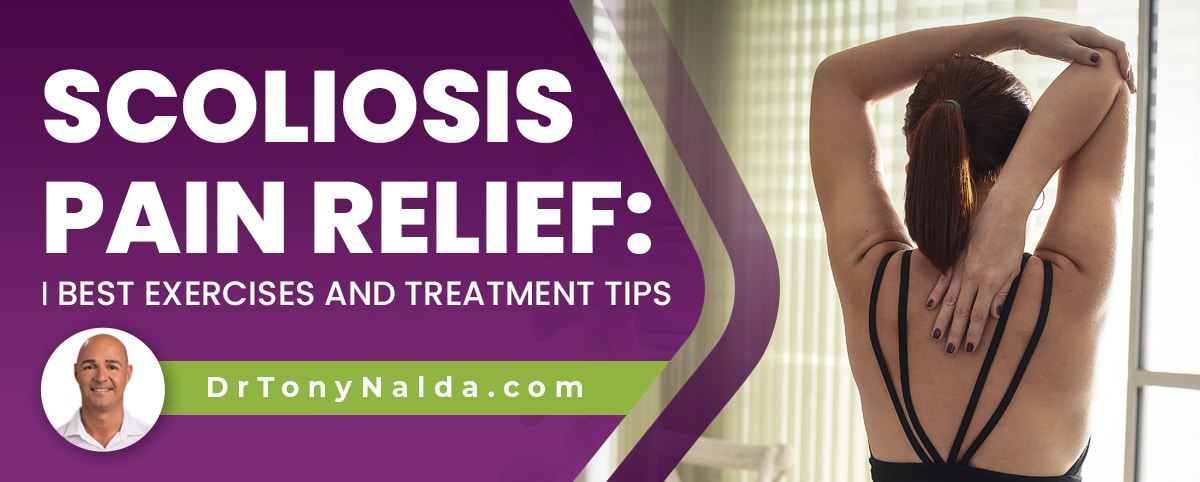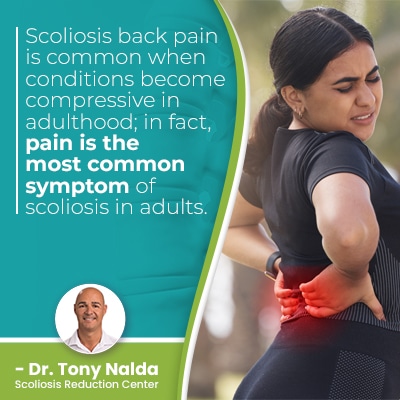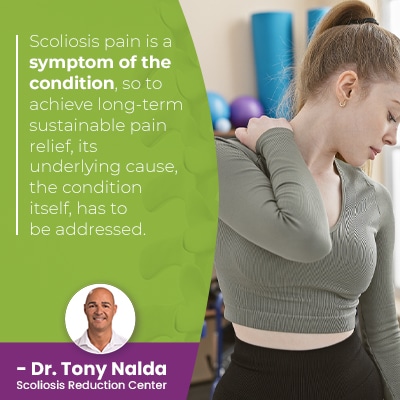Scoliosis Pain Relief: Best Exercises and Treatment Tips

An important fact about scoliosis is that not everyone will experience pain. Important factors that shape how painful a condition is likely to be include patient age and condition severity. Patient age is closely related to pain and progression, and scoliosis ranges widely in severity.
The best way to relieve pain caused by scoliosis is to treat its underlying cause proactively: the condition itself. The best exercises for pain relief are those that have corrective potential, keep the spine flexible and strong, and help strengthen core muscles.
As scoliosis isn't always painful, let's address why.
Table of Contents
Scoliosis Pain
Scoliosis causes the spine to bend to the side unnaturally and also twist, making it a 3-dimensional spinal condition.
Scoliosis introduces a lot of uneven forces to the spine, its surrounding muscles and nerves, and the entire body, and this can cause a number of effects.
Scoliosis pain can include muscle pain, back pain, and pain that radiates into the extremities due to nerve compression, but not everyone will experience scoliosis pain, and important determining factors are patient age and condition severity.
Scoliosis Muscle Pain
 It's not just the spine that maintains its natural curves and alignment, but also the spine's surrounding muscles that are responsible for supporting and stabilizing the spine.
It's not just the spine that maintains its natural curves and alignment, but also the spine's surrounding muscles that are responsible for supporting and stabilizing the spine.
Scoliosis is an asymmetrical condition; its uneven forces are associated with a muscular imbalance.
An unnaturally-curved spine can pull its surrounding muscles in different directions, causing the muscles on one side to become stretched and sore from overuse and the muscles on the other side to become weak from underuse.
Unbalanced muscles are part of the condition's asymmetrical effects.
Scoliosis Back Pain
Scoliosis back pain is common when conditions become compressive in adulthood; in fact, pain is the most common symptom of scoliosis in adults.
There are three main spinal sections: the cervical spine (neck), the thoracic spine (middle/upper back), and the lumbar spine (lower back).
Scoliosis back pain is most likely to be felt in the spinal section affected by the scoliosis, and the area of the body located the closest is also the most likely to be affected.
Scoliosis back pain can be caused by the structural changes within the spine putting pressure on the spine and its surroundings.
Radiating Scoliosis Pain
Compression is uneven pressure, and pain that radiates into the extremities due to nerve compression is the main reason adults come to see me for a diagnosis and treatment.
Scoliosis doesn't become compressive until skeletal maturity has been reached, and when that happens, the spine and its surroundings become vulnerable to the condition's uneven pressure.
In patients who are still growing, their spines are undergoing a constant lengthening motion that counteracts the compressive force of the unnatural spinal curve.
The spine has a hollow center formed by the vertebral bodies through which the spinal cord passes, and the spinal cord is a bundle of nerves, 31 pairs of spinal nerves; the brain and spine work together to form the body's central nervous system (CNS).
Nerve pain that's left unaddressed can lead to nerve damage and cause chronic back pain.
Patient Age
So patient age is an important factor when it comes to scoliosis pain because younger patients who are still growing don't experience compression-related pain.
Patient age is also a key factor when it comes to pain because it's closely tied to condition severity.
As a progressive condition, the nature of scoliosis is to get worse over time, and while we don't always know what causes scoliosis to develop initially, we know it's growth that triggers it to progress.
The more scoliosis progresses, the more severe it is, and the more likely it is that its effects will be noticeable.
The most prevalent type of scoliosis overall is adolescent idiopathic scoliosis diagnosed between the ages of 10 and 18, and this age group is the most at risk for rapid-phase progression due to the rapid and unpredictable growth spurts of puberty.
Condition Severity
The more severe scoliosis is, the larger the unnatural spinal curve is, and the more overt the condition's effects are going to be, including pain and postural changes.
In children, the most common symptoms of scoliosis include postural changes such as uneven shoulders and hips.
Condition severity ranges from mild scoliosis to moderate scoliosis, severe and very severe scoliosis, and this is also the condition's progressive line. Condition severity is determined by a measurement known as Cobb angle, and it's determined during x- ray.
Treatment for Pain Relief
Scoliosis pain is a symptom of the condition, so to achieve long-term sustainable pain relief, its underlying cause, the condition itself, has to be addressed.
As a structural spinal condition, its underlying structural nature has to be addressed, and conservative treatment works towards this through condition-specific chiropractic care.
Chiropractic adjustments can adjust the position of the curve's most-tilted vertebrae and improve their alignment with the rest of the spine.
Curvature Reductions and Strength Building
 Achieving a curvature reduction is addressing the structural abnormality within the spine itself so will improve structural pain, and this also reduces the conditions uneven forces, and their related effects: postural changes.
Achieving a curvature reduction is addressing the structural abnormality within the spine itself so will improve structural pain, and this also reduces the conditions uneven forces, and their related effects: postural changes.
For curvatures that are compressive, reducing their size means less pressure on the spine and its surroundings, so this also can improve radiating pain by relieving pressure on the spinal nerves.
Physical therapy and scoliosis exercises are important facets of conservative nonsurgical options because the spine needs strong surrounding muscles to support and stabilize it, and increasing strength of the abdominal muscles means more support and stability for the spine.
Physical therapy and a scoliosis-specific exercise regimen can also help improve posture and address any related muscular imbalance to improve muscle pain.
Simply practicing better posture can improve quality of life for people with scoliosis.
So treating scoliosis can mean improving spinal health and preventing damaged spinal nerves, progression, and increasing condition effects like pain.
Spinal alignment is important for spinal health and function; a spine that's alignment is one that's balanced and stable.
Exercises for Scoliosis Pain Relief
While no exercise should be attempted without first having it cleared by a patient's scoliosis treatment provider, when custom designed by a scoliosis physical therapist and proper technique is applied, a person's scoliosis can be improved, along with providing pain management.
Scoliosis-specific exercises can help with pain relief in two main ways: as part of treatment working towards corrective results and by keeping the spine and its surrounding muscles strong and flexible.
No exercise or exercise regimen on its own can address scoliosis, but when combined with additional medical treatments, it can help augment corrective treatment results and ease pain.
Pelvic Tilts
Pelvic tilts can be particularly helpful for lower back pain by keeping the pelvis and hips loose and flexible, and this helps maintain an economical gait.
Arm/Leg Raises
Arm/leg raises engage the lower back and leg muscles, and this is where the spine get's the majority of its support, so this will help keep the spine supported.
Planking
Planking is an effective exercise for strength building, and for people with scoliosis, it can be particularly suitable because it works the body's muscles symmetrically; exercises and activities that overuse one side of the body can exacerbate the condition's asymmetrical effects.
Planking can increase core strength and help improve body position naturally.
Conclusion
Pain is a symptom of scoliosis, and while using pain medication can provide short-term pain relief, it will do little for sustainable long-term effects.
To impact pain permanently, scoliosis has to be treated effectively, and this can involve surgical treatment or conservative nonsurgical options.
Scoliosis pain can involve muscle pain, localized back pain, and/or pain that radiates into the extremities due to nerve compression.
Surgical treatment involves spinal fusion, which is a risky, costly, and invasive procedure that in some cases, causes an increase in back pain as the spine is fixed and immovable in the fused portion.
Nonsurgical options offer a more natural and less invasive alternative to surgical treatment options.
A treatment plan that's proactive is started as close to the time of diagnosis as possible when conditions are likely to be at their most responsive, and a proactive response is a defining feature of conservative treatment.
A general healthcare provider can help address general symptoms of scoliosis, but a scoliosis specialist is required to customize treatment plans capable of impacting the complex 3-dimensional spinal condition on multiple levels as necessary.
Here at the Scoliosis Reduction Center®, patients benefit from a multi-faceted conservative treatment approach that combines the power of condition-specific chiropractic care, physical therapy, scoliosis exercises, physical therapy, scoliosis bracing, and rehabilitation.
Dr. Tony Nalda
DOCTOR OF CHIROPRACTIC
After receiving an undergraduate degree in psychology and his Doctorate of Chiropractic from Life University, Dr. Nalda settled in Celebration, Florida and proceeded to build one of Central Florida’s most successful chiropractic clinics.
His experience with patients suffering from scoliosis, and the confusion and frustration they faced, led him to seek a specialty in scoliosis care. In 2006 he completed his Intensive Care Certification from CLEAR Institute, a leading scoliosis educational and certification center.
About Dr. Tony Nalda
 Ready to explore scoliosis treatment? Contact Us Now
Ready to explore scoliosis treatment? Contact Us Now





